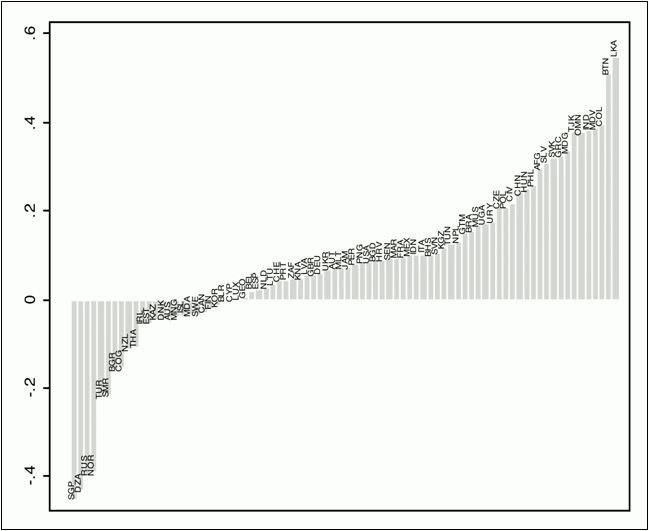The dire outlook of the global economy in the second half of 2008 necessitated unprecedented fiscal expansions in most OECD and emerging-market countries (WEO 2009). The resultant fiscal stimuli focused attention on the degree to which countries possessed “fiscal space” and on ways to apply it in a counter-cyclical manner.
But what does “fiscal space” mean? In attempting to clarify this fuzzy concept, Heller (2005) defined it “as room in a government’s budget that allows it to provide resources for a desired purpose without jeopardising the sustainability of its financial position or the stability of the economy.” In a recent paper (Aizenman and Jinjarak 2010), we aim at defining a measurable “fiscal space” variable, and apply this concept in the context of the global crisis.
We propose the concept of a de facto fiscal space as being inversely related to the tax-years it would take to repay the public debt. A useful notion is the de facto tax base, measuring the realised tax collection, averaged across several years to smooth for business cycle fluctuations. The ratio of the outstanding public debt to the de facto tax base, or the tax-years needed to repay the public debt, provides information about the relative fiscal tightness of countries.
Figure 1 reports this measure of 81 countries, subject to data availability in 2006. It shows the wide variation in the tax-years needed to repay the public debt, from well below one year in Australia (indicating a high fiscal space), to about five years in Brazil, and above 10 years in Madagascar (indicating a very low fiscal space).
Figure 1. De facto fiscal space measure based on public debt and tax revenue
Notes: This figure plots country’s fiscal space as measured by inverse of the tax-years needed to repay the public debt. The variable Fiscal space 1 is defined by [2006 Debt/GDP] / [2000-06 Average Tax Revenue/GDP], where all variables are deflated by 2006 CPI. Source: Authors’ calculation from the World Development Indicators.
For most of the countries in our sample, the tax-years it would take to repay the public debt in 2006 were below four years. Figure 2 reports another measure of fiscal tightness, focusing on flows instead of stocks, i.e. on fiscal deficits instead of public debt: the average fiscal deficits relative to the average tax revenue. Both figures are consistent with the notion that, even without increasing the tax base, a fair share of countries had significant fiscal space in 2006.1
Figure 2. De facto fiscal space based on fiscal deficit and tax revenue.
Notes: This figure plots country’s fiscal space as measured by inverse of average fiscal deficits/public debt. The variable Fiscal space 2 is defined by [2000-06 Average Fiscal Deficit/GDP] / [2000-06 Average Tax Revenue/GDP], where all variables are deflated by 2006 CPI. Source: Authors’ calculation from the World Development Indicators.
We apply these concepts in order to explain the cross-country variation in the fiscal stimulus during the aftermath of the global crisis. The pre-crisis tax revenue measures the de facto tax capacity in years of relative tranquillity during the early 2000s – the Great Moderation. The presumption is that a lower pre-crisis public debt and lower average fiscal deficits relative to the pre-crisis tax base imply greater fiscal capacity to fund stimuli using the existing tax capacity.
Figure 3 summarises the averages of these measures for the low, lower-middle, upper middle, and high-income countries. The Figure suggests that in 2006, the middle income countries’ fiscal space was higher than the low income countries. While the debt overhangs [2006 public debt/GDP] of the low and lower middle income countries are slightly above the other groups, their ratio to the tax base is much higher than that of the upper middle income and the OECD countries. This in turn implies that the low- and lower-middle income countries may have more limited fiscal space than the upper-middle income and the OPEC countries. Consequently, the fiscal stimuli of the richer countries would have the side benefit of helping the poorer countries in invigorating the demands facing lower income countries.
Figure 3. De facto fiscal space by income classification.
Notes: This Figure presents the level of public debt/GDP in 2006 and two measures of fiscal space: Public Debt/Tax Revenue (Fiscal space 1) and Fiscal Deficit/Tax Revenue (Fiscal space 2). All variables are deflated by 2006 CPI. See Table 2 for country-level data. Source: Authors’ calculation from the World Development Indicators.
The crisis led to a significant fiscal stimulus in the US, Japan, and Germany, the magnitude of which increased from 2009 to 2010, reflecting various lags associated with fiscal policy. In the US, Germany, and the UK, massive “bailout” transfers to the banking systems were put in place as an attempt to stabilise the financial panic. In Germany and the UK the size of these transfers to the financial systems exceeded the fiscal stimulus to the non-financial sector.
Similar trends, though in varying intensity, were observed in emerging markets. China, South Korea, and Russia provided front-loaded fiscal stimulus at rates that were well above the one observed in the OECD countries. Notable is the greater agility of the emerging markets’ response relative to that of the OECD countries, reflecting possibly a faster policy response capacity of several emerging markets.2 This observation is remarkable considering the earlier evidence of the fiscal pro-cyclicality observed in emerging markets and developing countries during the 1980s-90s (see Kaminsky, Reinhart and Végh 2005).
In our paper (Aizenman and Jinjarak 2010) we perform a regression analysis, accounting for the cross-country variation in the fiscal stimulus during 2009-2010, in 75 (out of 81) countries. We find that a greater de facto fiscal space, higher GDP per capita, higher financial exposure to the US, and lower trade openness were positively associated with fiscal stimulus/GDP during 2009-2010.
For each explanatory variable, we multiply its standard deviation with the estimated coefficient in the regression, to approximate the effect of its one standard deviation change on the size of fiscal stimulus. For the de facto fiscal space measure, a decrease in the public debt/tax revenue to that of the high income OECD group implies, all other things being equal, an increase of the fiscal stimulus during 2009-2010 by 0.26% of GDP.
Conclusions
Our analysis shows the usefulness of the de facto fiscal space concept in accounting for the size of fiscal stimulus.
Intriguingly, we found that higher trade openness had been associated with a lower fiscal stimulus. A possible interpretation is that, as fiscal multipliers may be lower in more open economies, these countries opted for a smaller fiscal stimulus, putting greater weight on adjustment via exchange-rate depreciation (“exporting their way to prosperity”). This interpretation is supported by our detailed statistical investigations of fiscal stimulus and exchange rate depreciations. We found that greater trade openness is robustly associated with a lower fiscal stimulus and higher depreciation rate from 2009 to 2010.
Our results validate the presence of gains associated with greater fiscal coordination among countries. A coordinated fiscal stimulus may generate positive spillover effects, mitigating the reliance on competitive depreciations.
References
Aizenman, J and Y Jinjarak (2010), “De facto Fiscal Space and Fiscal Stimulus: Definition and Assessment”, NBER Working Paper 16539.
Aizenman J and G Pasricha (2010), “Fiscal Fragility: What the Past may say about the Future”, NBER Working paper 16478, September.
Aizenman, J and Y Jinjarak (2009), “Globalisation and Developing Countries - a Shrinking Tax Base?”, Journal of Development Studies, 45(5):653-671.
Fiscal Monitor (2010), “Navigating the Fiscal Challenges Ahead”, Fiscal Affairs Department, IMF, May.
Heller, SP (2005), “Back to Basics – Fiscal Space: What It Is and How to Get It”, Finance and Development, 42(2), June.
Kaminsky, GL, CM Reinhart and CA Végh (2005), “When It Rains, It Pours: Procyclical Capital Flows and Macroeconomic Policies”, NBER Macroeconomics Annual, 19:11-53.
World Economic Outlook (2009), “Crisis and Recovery”, World Economic and Financial Surveys, IMF, April.
1 This inference is in line with Aizenman and Pasricha (2010), finding that the projected flow cost of public debt is low for about half of the OECD countries. See Aizenman and Jinjarak (2009) for a study accounting for the cross country variation in the de facto tax base.
2 The deeper safety net of the OECD [unemployment insurance, food stamps, social security, socialised medical care, etc.] provides automatic stabilisers that work to cushion the economy in addition to the crisis related stimulus.






